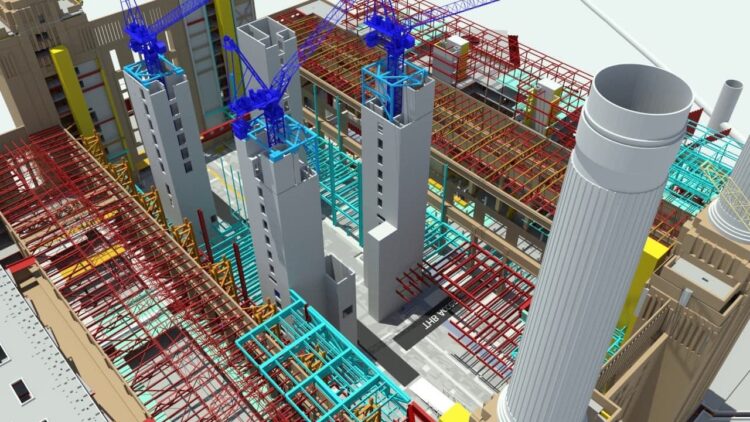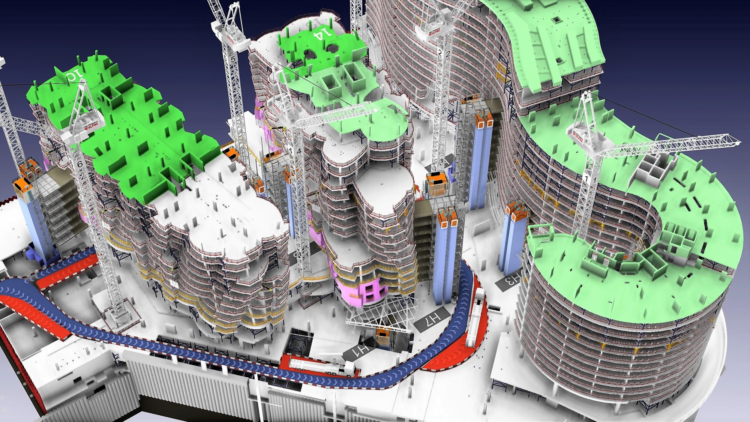4D planning is the process of using deliverables to visualize and understand construction projects. The two main deliverables used in 4D planning (used in combination with one another) are 3D models and project schedules.
4D can be used with complementary technology like BIM for planning and scheduling purposes, creating an intelligent link between work schedules, timelines, and 3D models. To increase the accuracy of construction plans, it’s advisable to use technologies that leverage 4D planning.
For example, when using ALICE during the preconstruction phase, you get access to a 4D schedule that makes it easier for you to view resource curves, key performance indicators, and costs over a given period. These generated insights allow you to make more informed decisions.
How are 4D models produced?

To create a 4D model, you must first have a construction schedule and a 3D model ready. They’ll then need to be imported into a 4D-compatible program—in some cases, the 3D model will need to be pre-processed to be compatible.
After that, specific tasks must be incorporated to create a 4D sequence. 4D models can be created in two ways: through manual creation or automated element synchronization.
Manual 4D model creation is time-consuming and should be avoided. When opting for the automated method, there must be a common attribute that connects the desired 3D elements with required scheduled activities.
At which stage should 4D planning be used?
Though contractors can use 4D planning at any stage of the construction process, they’ll benefit more when 4D planning is implemented during the initial stages of construction. For example, construction companies may use 4D to visually show the scope of work to be done to project owners.
Project owners can also use the technology during other early stages, including tendering. Contractors can, for instance, use 4D planning to demonstrate how they will implement the project by demonstrating an installation sequence.
A good example of how project owners can use 4D planning in the tendering phase is when they are tendering on a complex project such as airport construction. In this case, the contractor can use 4D planning to demonstrate how they will implement the project by showing a detailed installation sequence.
The benefits of 4D planning

One main advantage of 4D planning is the ability to come up with more accurate estimates, as scopes of work become more clearly defined. 4D also makes it easier for contractors to ensure accuracy in planning since engineers and designers can visualize designs in greater detail.
Additionally, 4D planning facilitates better collaboration between key stakeholders. Enhanced communication allows errors to be identified early before they’re implemented, preventing delays. Workers are also more likely to know exactly what is required of them, which ensures that projects will be completed on time and within budget.
Companies that make use of 4D planning can significantly reduce risk in the workplace. This is because it creates a suitable platform for independent contractors to peer review designs and identify flaws that could have been missed if not visualized.
Many find that 4D planning results in increased productivity because of its ability to provide spatial planning, though contractors also benefit by using 4D planning to reduce equipment costs, as it optimizes time and resources.
Gantt charts and 4D planning
As a general contractor, at some point in your career, you have probably interacted with a Gantt chart. Gantt charts are used in project management to guide contractors and subcontractors on project activities that are required and must be completed.
These activities are linked with a suitable time frame to protect the project from delays, with each activity represented by a bar that indicates the start and end dates. This chart also lets contractors view which activities overlap.
Though a man named Henry Gantt developed the chart in 1910, it’s still used today, and technological platforms have developed to leverage this method of task management. After all, most people are visual learners and understand things better based on what they see.
However, it should be noted that, compared to 4D planning, Gantt charts have several disadvantages. For one, they can be complicated to follow, especially when manually managed on large construction projects. Imagine having to track and follow hundreds of tasks on an Excel sheet. This can be time-consuming and, especially during labor shortages, impossible to do.
Though the Gantt chart has been used for over a hundred years, it has its shortcomings, especially when building complex structures. In cases such as this, Gantt charts should be used complementary to and in conjunction with 4D planning for advisement purposes.
The future of 4D planning

4D technology is currently being used to implement complex and sophisticated projects like rail and bridge construction. As technology evolves, the integration of 4D planning with optioneering, artificial intelligence, and big data technologies will likely see increased use for construction teams to build much faster and safer.
4D planning solves key challenges while increasing efficiency. Construction teams can reduce risk and optimize their available time and resources. To leverage this technology and benefit, construction companies will not only need to hire a specialist who understands how to use 4D technology but enlist the help of the right technologies.
4D is a useful tool
4D planning is a useful construction management methodology to assist with the effective planning and tracking of construction projects. Often used for both residential and commercial construction projects, there are several software programs that you can use to leverage this technique for your project. It’s often used in tandem with technologies and methods like BIM and Gantt charts.
The benefits of using 4D planning include significantly improved communication, reduced costs, decreased project duration, and less risk. You can catch potential problems and correct them before they become actual issues, with 4D planning helping to ensure that your project runs smoothly.
We hope this guide has helped you understand 4D planning. If you are considering using 4D planning in your next few construction projects, make sure to consult with all team members for successful coordination.
 Hi Boox Popular Magazine 2024
Hi Boox Popular Magazine 2024



